Economics Development - Solved Assignment
VerifiedAdded on 2021/05/31
|14
|3546
|38
AI Summary
Contribute Materials
Your contribution can guide someone’s learning journey. Share your
documents today.
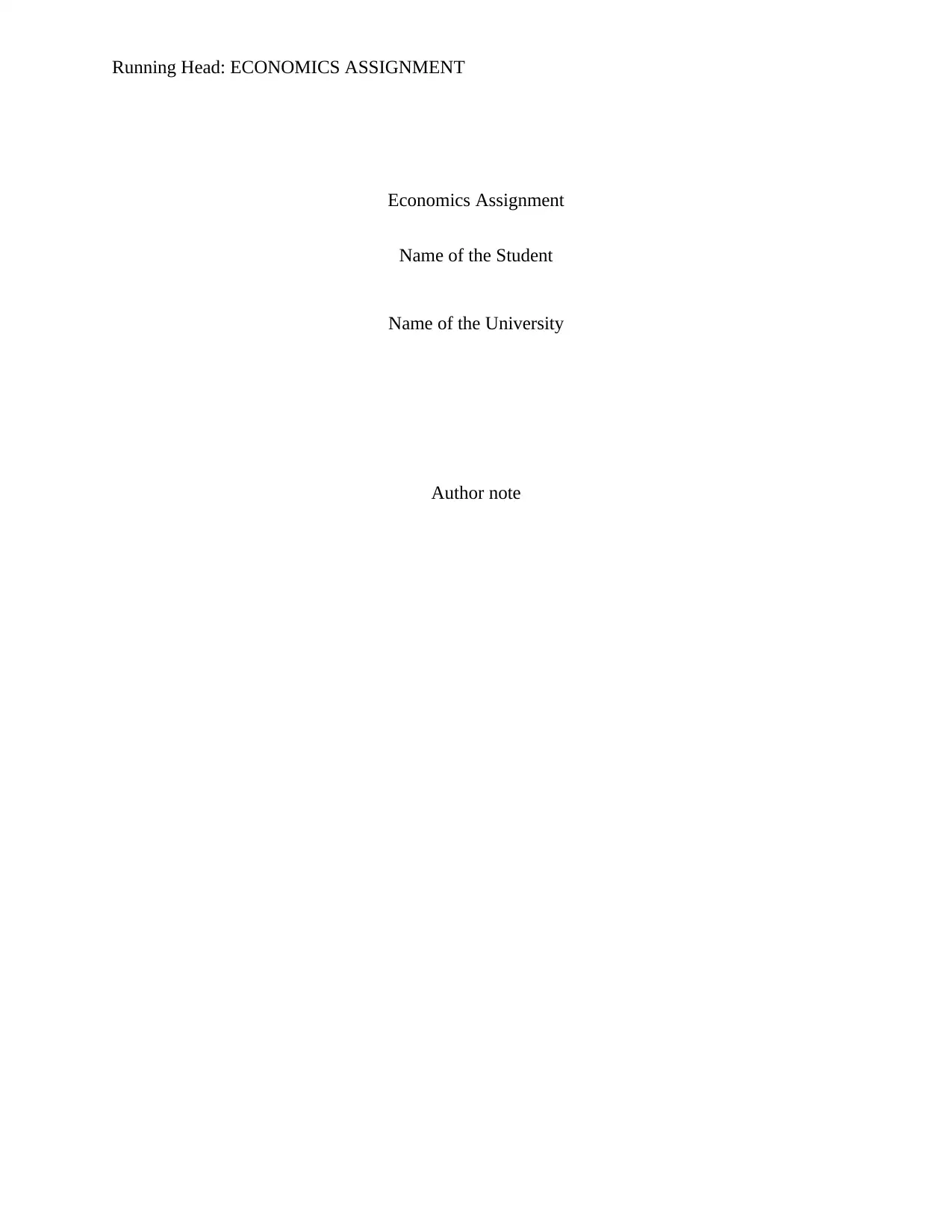
Running Head: ECONOMICS ASSIGNMENT
Economics Assignment
Name of the Student
Name of the University
Author note
Economics Assignment
Name of the Student
Name of the University
Author note
Secure Best Marks with AI Grader
Need help grading? Try our AI Grader for instant feedback on your assignments.
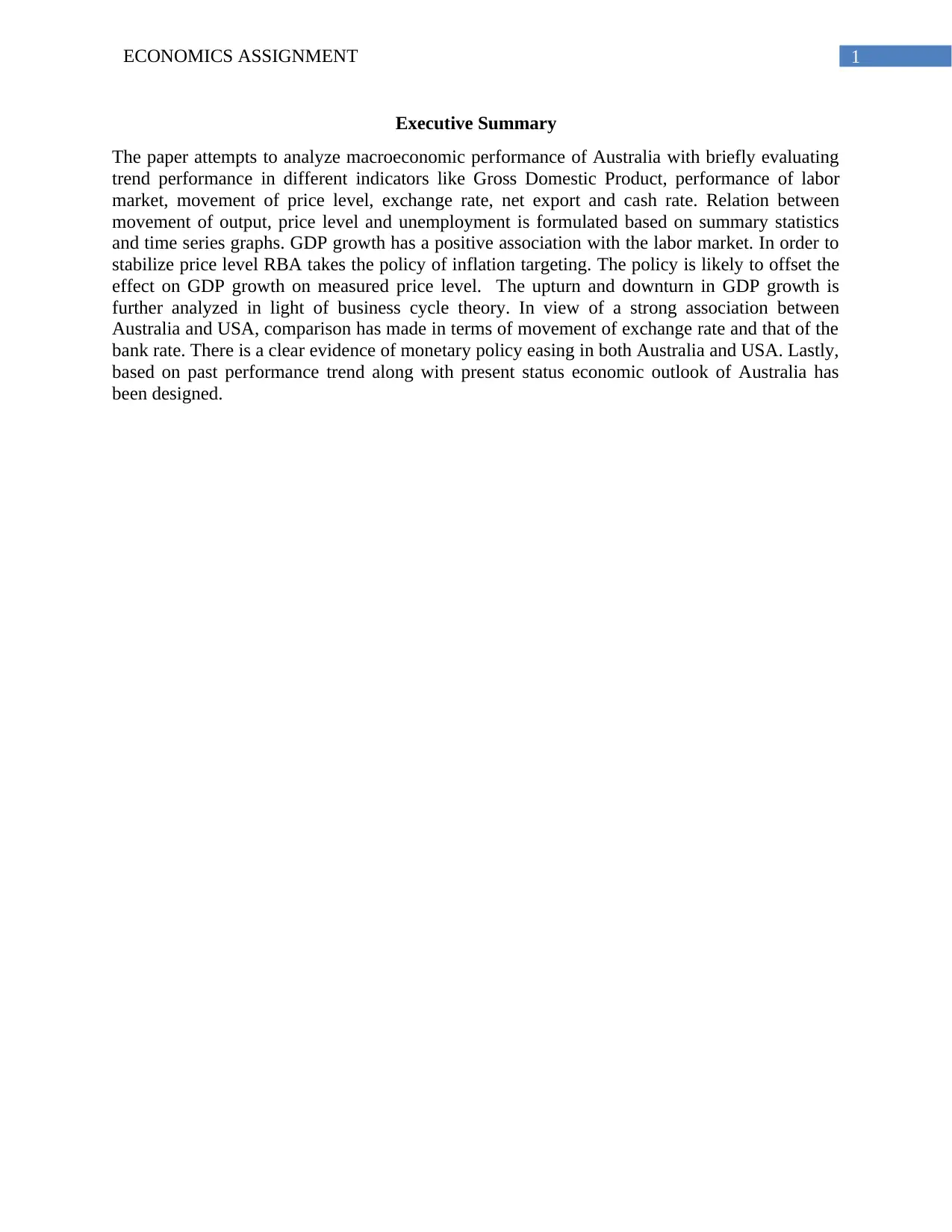
1ECONOMICS ASSIGNMENT
Executive Summary
The paper attempts to analyze macroeconomic performance of Australia with briefly evaluating
trend performance in different indicators like Gross Domestic Product, performance of labor
market, movement of price level, exchange rate, net export and cash rate. Relation between
movement of output, price level and unemployment is formulated based on summary statistics
and time series graphs. GDP growth has a positive association with the labor market. In order to
stabilize price level RBA takes the policy of inflation targeting. The policy is likely to offset the
effect on GDP growth on measured price level. The upturn and downturn in GDP growth is
further analyzed in light of business cycle theory. In view of a strong association between
Australia and USA, comparison has made in terms of movement of exchange rate and that of the
bank rate. There is a clear evidence of monetary policy easing in both Australia and USA. Lastly,
based on past performance trend along with present status economic outlook of Australia has
been designed.
Executive Summary
The paper attempts to analyze macroeconomic performance of Australia with briefly evaluating
trend performance in different indicators like Gross Domestic Product, performance of labor
market, movement of price level, exchange rate, net export and cash rate. Relation between
movement of output, price level and unemployment is formulated based on summary statistics
and time series graphs. GDP growth has a positive association with the labor market. In order to
stabilize price level RBA takes the policy of inflation targeting. The policy is likely to offset the
effect on GDP growth on measured price level. The upturn and downturn in GDP growth is
further analyzed in light of business cycle theory. In view of a strong association between
Australia and USA, comparison has made in terms of movement of exchange rate and that of the
bank rate. There is a clear evidence of monetary policy easing in both Australia and USA. Lastly,
based on past performance trend along with present status economic outlook of Australia has
been designed.
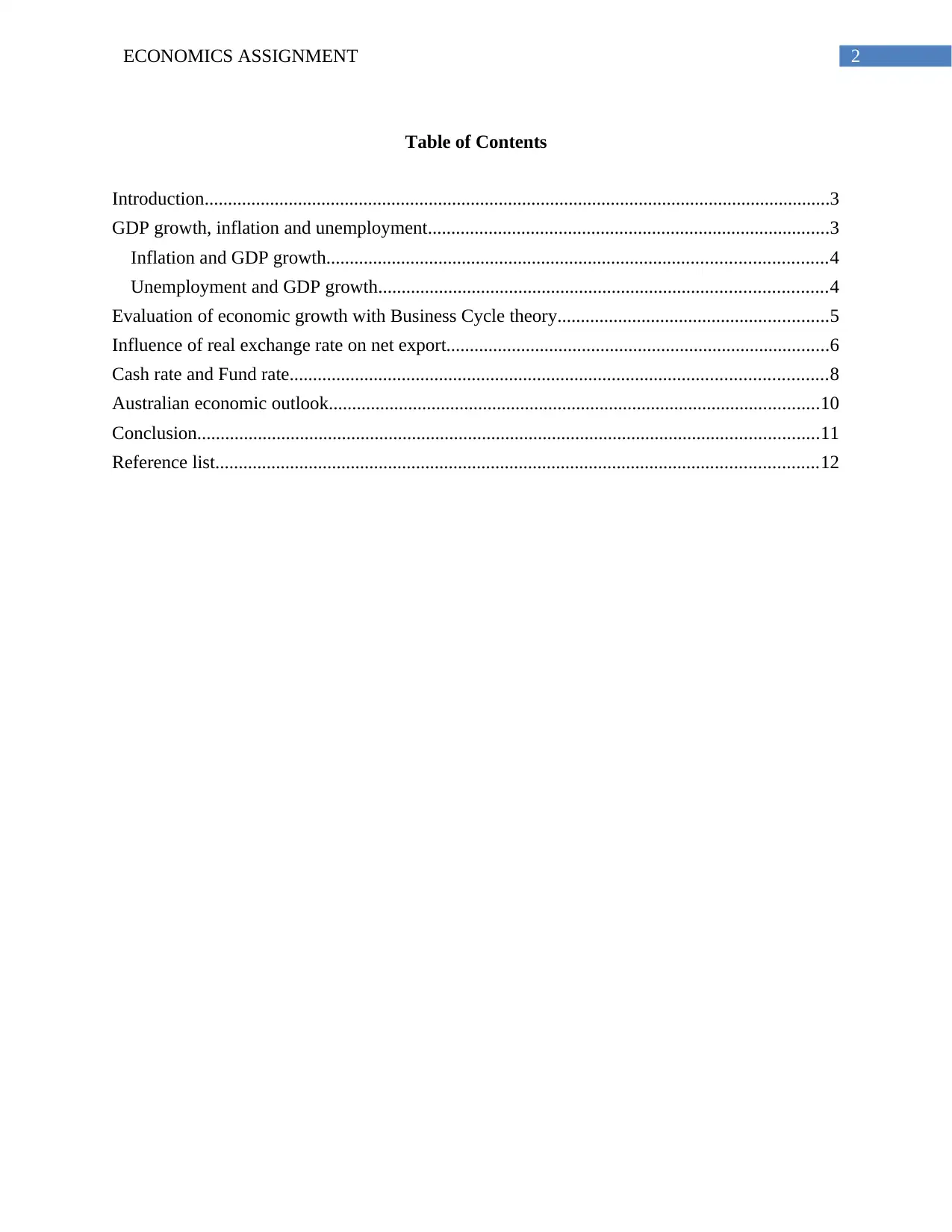
2ECONOMICS ASSIGNMENT
Table of Contents
Introduction......................................................................................................................................3
GDP growth, inflation and unemployment......................................................................................3
Inflation and GDP growth...........................................................................................................4
Unemployment and GDP growth................................................................................................4
Evaluation of economic growth with Business Cycle theory..........................................................5
Influence of real exchange rate on net export..................................................................................6
Cash rate and Fund rate...................................................................................................................8
Australian economic outlook.........................................................................................................10
Conclusion.....................................................................................................................................11
Reference list.................................................................................................................................12
Table of Contents
Introduction......................................................................................................................................3
GDP growth, inflation and unemployment......................................................................................3
Inflation and GDP growth...........................................................................................................4
Unemployment and GDP growth................................................................................................4
Evaluation of economic growth with Business Cycle theory..........................................................5
Influence of real exchange rate on net export..................................................................................6
Cash rate and Fund rate...................................................................................................................8
Australian economic outlook.........................................................................................................10
Conclusion.....................................................................................................................................11
Reference list.................................................................................................................................12
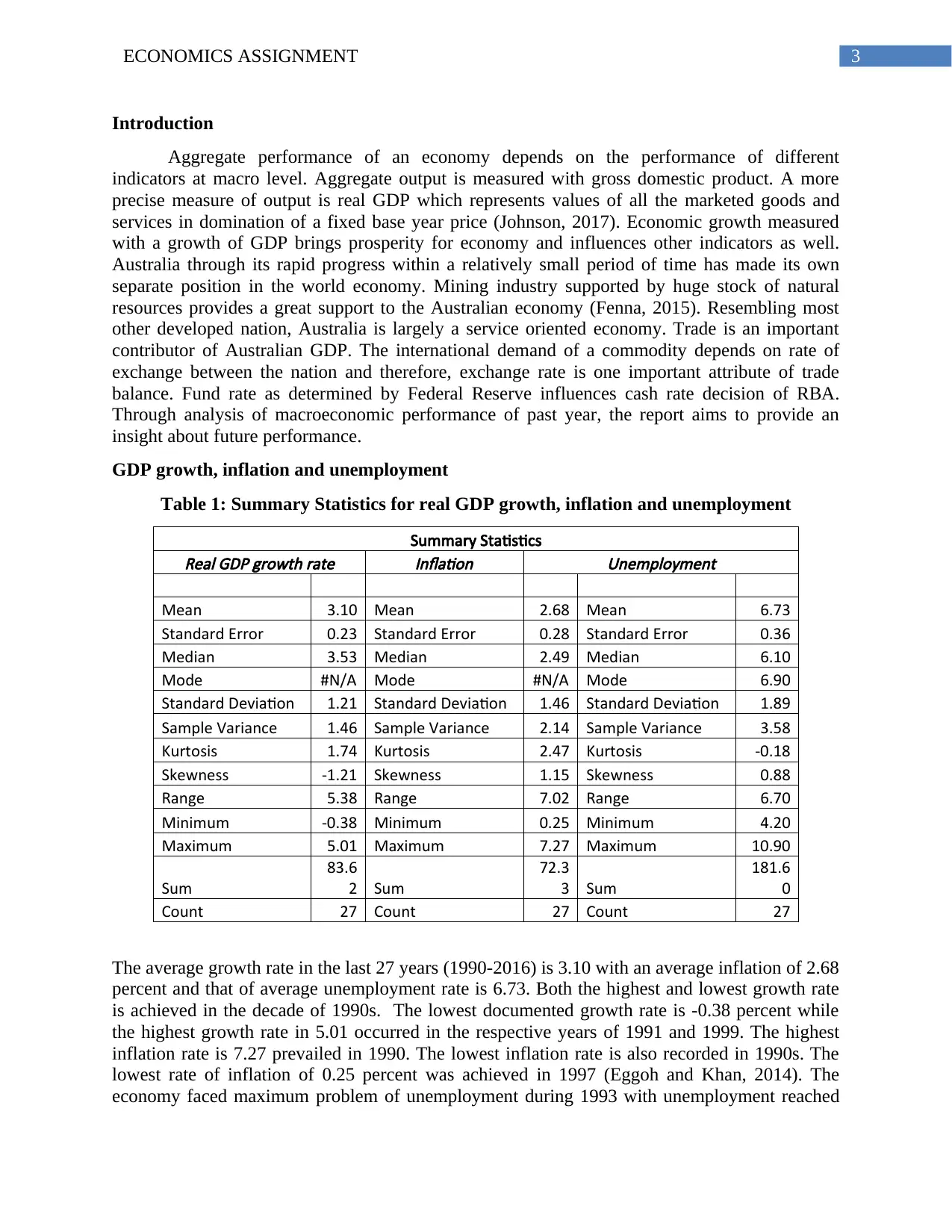
3ECONOMICS ASSIGNMENT
Introduction
Aggregate performance of an economy depends on the performance of different
indicators at macro level. Aggregate output is measured with gross domestic product. A more
precise measure of output is real GDP which represents values of all the marketed goods and
services in domination of a fixed base year price (Johnson, 2017). Economic growth measured
with a growth of GDP brings prosperity for economy and influences other indicators as well.
Australia through its rapid progress within a relatively small period of time has made its own
separate position in the world economy. Mining industry supported by huge stock of natural
resources provides a great support to the Australian economy (Fenna, 2015). Resembling most
other developed nation, Australia is largely a service oriented economy. Trade is an important
contributor of Australian GDP. The international demand of a commodity depends on rate of
exchange between the nation and therefore, exchange rate is one important attribute of trade
balance. Fund rate as determined by Federal Reserve influences cash rate decision of RBA.
Through analysis of macroeconomic performance of past year, the report aims to provide an
insight about future performance.
GDP growth, inflation and unemployment
Table 1: Summary Statistics for real GDP growth, inflation and unemployment
Summary Statistics
Real GDP growth rate
Inflation
Unemployment
Mean 3.10 Mean 2.68 Mean 6.73
Standard Error 0.23 Standard Error 0.28 Standard Error 0.36
Median 3.53 Median 2.49 Median 6.10
Mode #N/A Mode #N/A Mode 6.90
Standard Deviation 1.21 Standard Deviation 1.46 Standard Deviation 1.89
Sample Variance 1.46 Sample Variance 2.14 Sample Variance 3.58
Kurtosis 1.74 Kurtosis 2.47 Kurtosis -0.18
Skewness -1.21 Skewness 1.15 Skewness 0.88
Range 5.38 Range 7.02 Range 6.70
Minimum -0.38 Minimum 0.25 Minimum 4.20
Maximum 5.01 Maximum 7.27 Maximum 10.90
Sum
83.6
2 Sum
72.3
3 Sum
181.6
0
Count 27 Count 27 Count 27
The average growth rate in the last 27 years (1990-2016) is 3.10 with an average inflation of 2.68
percent and that of average unemployment rate is 6.73. Both the highest and lowest growth rate
is achieved in the decade of 1990s. The lowest documented growth rate is -0.38 percent while
the highest growth rate in 5.01 occurred in the respective years of 1991 and 1999. The highest
inflation rate is 7.27 prevailed in 1990. The lowest inflation rate is also recorded in 1990s. The
lowest rate of inflation of 0.25 percent was achieved in 1997 (Eggoh and Khan, 2014). The
economy faced maximum problem of unemployment during 1993 with unemployment reached
Introduction
Aggregate performance of an economy depends on the performance of different
indicators at macro level. Aggregate output is measured with gross domestic product. A more
precise measure of output is real GDP which represents values of all the marketed goods and
services in domination of a fixed base year price (Johnson, 2017). Economic growth measured
with a growth of GDP brings prosperity for economy and influences other indicators as well.
Australia through its rapid progress within a relatively small period of time has made its own
separate position in the world economy. Mining industry supported by huge stock of natural
resources provides a great support to the Australian economy (Fenna, 2015). Resembling most
other developed nation, Australia is largely a service oriented economy. Trade is an important
contributor of Australian GDP. The international demand of a commodity depends on rate of
exchange between the nation and therefore, exchange rate is one important attribute of trade
balance. Fund rate as determined by Federal Reserve influences cash rate decision of RBA.
Through analysis of macroeconomic performance of past year, the report aims to provide an
insight about future performance.
GDP growth, inflation and unemployment
Table 1: Summary Statistics for real GDP growth, inflation and unemployment
Summary Statistics
Real GDP growth rate
Inflation
Unemployment
Mean 3.10 Mean 2.68 Mean 6.73
Standard Error 0.23 Standard Error 0.28 Standard Error 0.36
Median 3.53 Median 2.49 Median 6.10
Mode #N/A Mode #N/A Mode 6.90
Standard Deviation 1.21 Standard Deviation 1.46 Standard Deviation 1.89
Sample Variance 1.46 Sample Variance 2.14 Sample Variance 3.58
Kurtosis 1.74 Kurtosis 2.47 Kurtosis -0.18
Skewness -1.21 Skewness 1.15 Skewness 0.88
Range 5.38 Range 7.02 Range 6.70
Minimum -0.38 Minimum 0.25 Minimum 4.20
Maximum 5.01 Maximum 7.27 Maximum 10.90
Sum
83.6
2 Sum
72.3
3 Sum
181.6
0
Count 27 Count 27 Count 27
The average growth rate in the last 27 years (1990-2016) is 3.10 with an average inflation of 2.68
percent and that of average unemployment rate is 6.73. Both the highest and lowest growth rate
is achieved in the decade of 1990s. The lowest documented growth rate is -0.38 percent while
the highest growth rate in 5.01 occurred in the respective years of 1991 and 1999. The highest
inflation rate is 7.27 prevailed in 1990. The lowest inflation rate is also recorded in 1990s. The
lowest rate of inflation of 0.25 percent was achieved in 1997 (Eggoh and Khan, 2014). The
economy faced maximum problem of unemployment during 1993 with unemployment reached
Secure Best Marks with AI Grader
Need help grading? Try our AI Grader for instant feedback on your assignments.
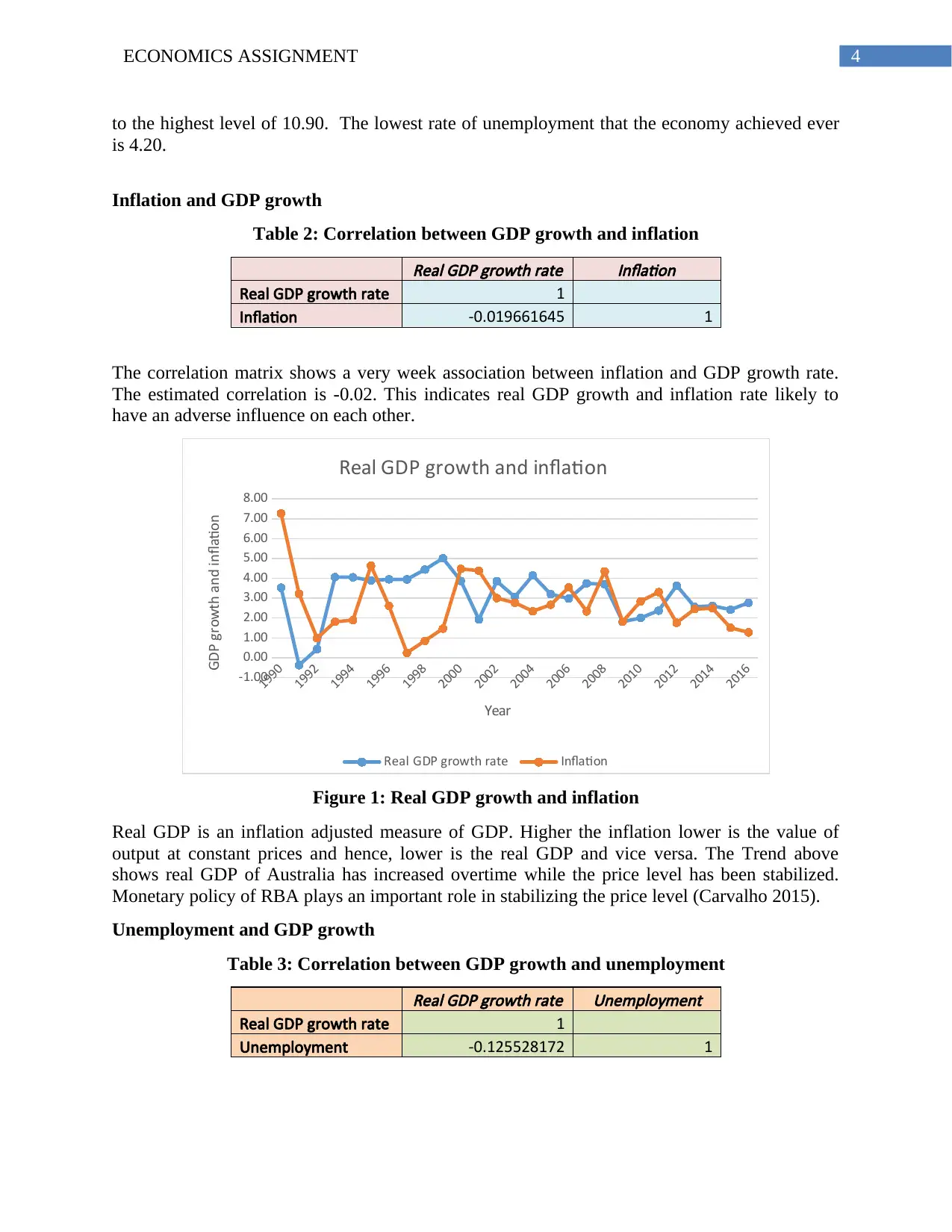
4ECONOMICS ASSIGNMENT
to the highest level of 10.90. The lowest rate of unemployment that the economy achieved ever
is 4.20.
Inflation and GDP growth
Table 2: Correlation between GDP growth and inflation
Real GDP growth rate Inflation
Real GDP growth rate 1
Inflation -0.019661645 1
The correlation matrix shows a very week association between inflation and GDP growth rate.
The estimated correlation is -0.02. This indicates real GDP growth and inflation rate likely to
have an adverse influence on each other.
1990
1992
1994
1996
1998
2000
2002
2004
2006
2008
2010
2012
2014
2016
-1.00
0.00
1.00
2.00
3.00
4.00
5.00
6.00
7.00
8.00
Real GDP growth and inflation
Real GDP growth rate Inflation
Year
GDP growth and inflation
Figure 1: Real GDP growth and inflation
Real GDP is an inflation adjusted measure of GDP. Higher the inflation lower is the value of
output at constant prices and hence, lower is the real GDP and vice versa. The Trend above
shows real GDP of Australia has increased overtime while the price level has been stabilized.
Monetary policy of RBA plays an important role in stabilizing the price level (Carvalho 2015).
Unemployment and GDP growth
Table 3: Correlation between GDP growth and unemployment
Real GDP growth rate Unemployment
Real GDP growth rate 1
Unemployment -0.125528172 1
to the highest level of 10.90. The lowest rate of unemployment that the economy achieved ever
is 4.20.
Inflation and GDP growth
Table 2: Correlation between GDP growth and inflation
Real GDP growth rate Inflation
Real GDP growth rate 1
Inflation -0.019661645 1
The correlation matrix shows a very week association between inflation and GDP growth rate.
The estimated correlation is -0.02. This indicates real GDP growth and inflation rate likely to
have an adverse influence on each other.
1990
1992
1994
1996
1998
2000
2002
2004
2006
2008
2010
2012
2014
2016
-1.00
0.00
1.00
2.00
3.00
4.00
5.00
6.00
7.00
8.00
Real GDP growth and inflation
Real GDP growth rate Inflation
Year
GDP growth and inflation
Figure 1: Real GDP growth and inflation
Real GDP is an inflation adjusted measure of GDP. Higher the inflation lower is the value of
output at constant prices and hence, lower is the real GDP and vice versa. The Trend above
shows real GDP of Australia has increased overtime while the price level has been stabilized.
Monetary policy of RBA plays an important role in stabilizing the price level (Carvalho 2015).
Unemployment and GDP growth
Table 3: Correlation between GDP growth and unemployment
Real GDP growth rate Unemployment
Real GDP growth rate 1
Unemployment -0.125528172 1
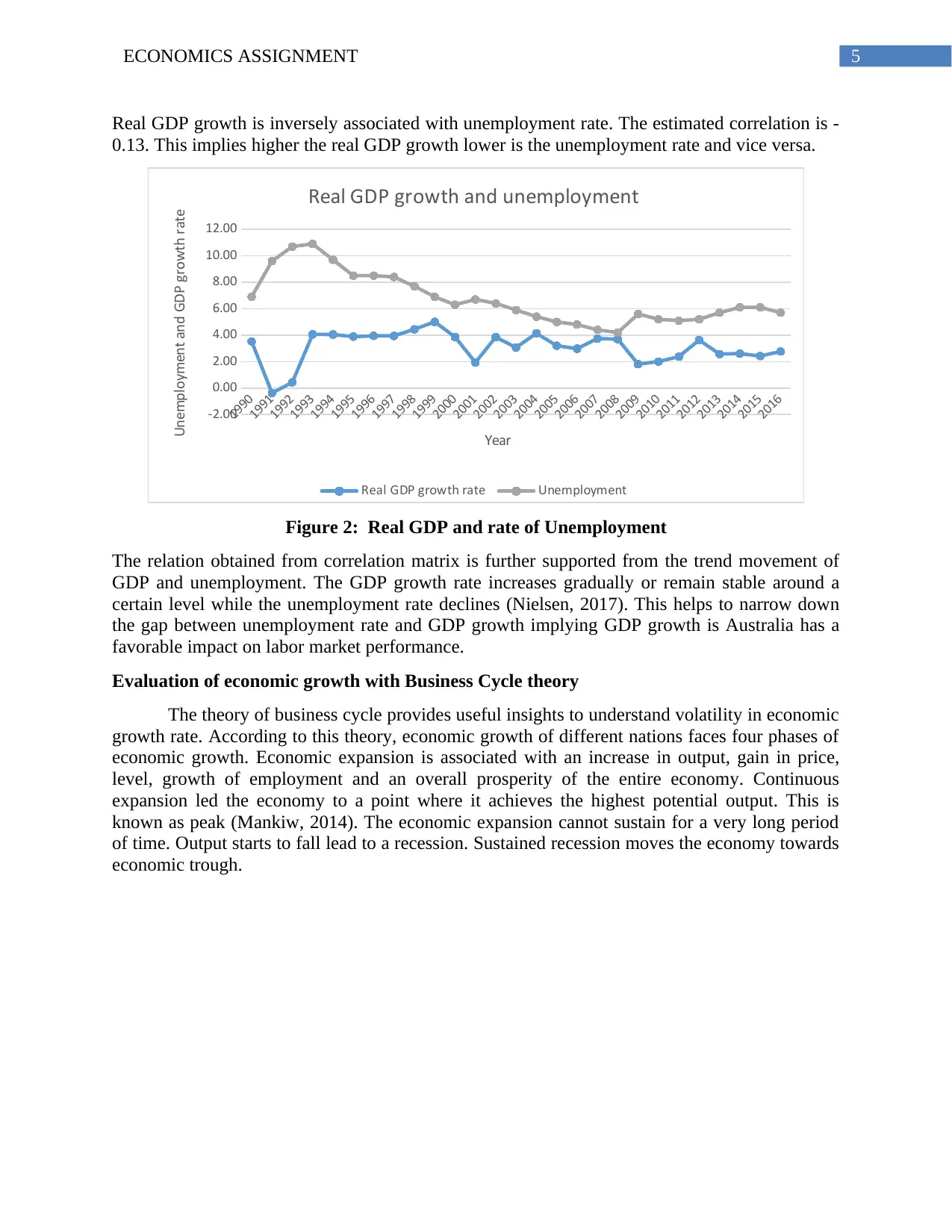
5ECONOMICS ASSIGNMENT
Real GDP growth is inversely associated with unemployment rate. The estimated correlation is -
0.13. This implies higher the real GDP growth lower is the unemployment rate and vice versa.
1990
1991
1992
1993
1994
1995
1996
1997
1998
1999
2000
2001
2002
2003
2004
2005
2006
2007
2008
2009
2010
2011
2012
2013
2014
2015
2016
-2.00
0.00
2.00
4.00
6.00
8.00
10.00
12.00
Real GDP growth and unemployment
Real GDP growth rate Unemployment
Year
Unemployment and GDP growth rate
Figure 2: Real GDP and rate of Unemployment
The relation obtained from correlation matrix is further supported from the trend movement of
GDP and unemployment. The GDP growth rate increases gradually or remain stable around a
certain level while the unemployment rate declines (Nielsen, 2017). This helps to narrow down
the gap between unemployment rate and GDP growth implying GDP growth is Australia has a
favorable impact on labor market performance.
Evaluation of economic growth with Business Cycle theory
The theory of business cycle provides useful insights to understand volatility in economic
growth rate. According to this theory, economic growth of different nations faces four phases of
economic growth. Economic expansion is associated with an increase in output, gain in price,
level, growth of employment and an overall prosperity of the entire economy. Continuous
expansion led the economy to a point where it achieves the highest potential output. This is
known as peak (Mankiw, 2014). The economic expansion cannot sustain for a very long period
of time. Output starts to fall lead to a recession. Sustained recession moves the economy towards
economic trough.
Real GDP growth is inversely associated with unemployment rate. The estimated correlation is -
0.13. This implies higher the real GDP growth lower is the unemployment rate and vice versa.
1990
1991
1992
1993
1994
1995
1996
1997
1998
1999
2000
2001
2002
2003
2004
2005
2006
2007
2008
2009
2010
2011
2012
2013
2014
2015
2016
-2.00
0.00
2.00
4.00
6.00
8.00
10.00
12.00
Real GDP growth and unemployment
Real GDP growth rate Unemployment
Year
Unemployment and GDP growth rate
Figure 2: Real GDP and rate of Unemployment
The relation obtained from correlation matrix is further supported from the trend movement of
GDP and unemployment. The GDP growth rate increases gradually or remain stable around a
certain level while the unemployment rate declines (Nielsen, 2017). This helps to narrow down
the gap between unemployment rate and GDP growth implying GDP growth is Australia has a
favorable impact on labor market performance.
Evaluation of economic growth with Business Cycle theory
The theory of business cycle provides useful insights to understand volatility in economic
growth rate. According to this theory, economic growth of different nations faces four phases of
economic growth. Economic expansion is associated with an increase in output, gain in price,
level, growth of employment and an overall prosperity of the entire economy. Continuous
expansion led the economy to a point where it achieves the highest potential output. This is
known as peak (Mankiw, 2014). The economic expansion cannot sustain for a very long period
of time. Output starts to fall lead to a recession. Sustained recession moves the economy towards
economic trough.
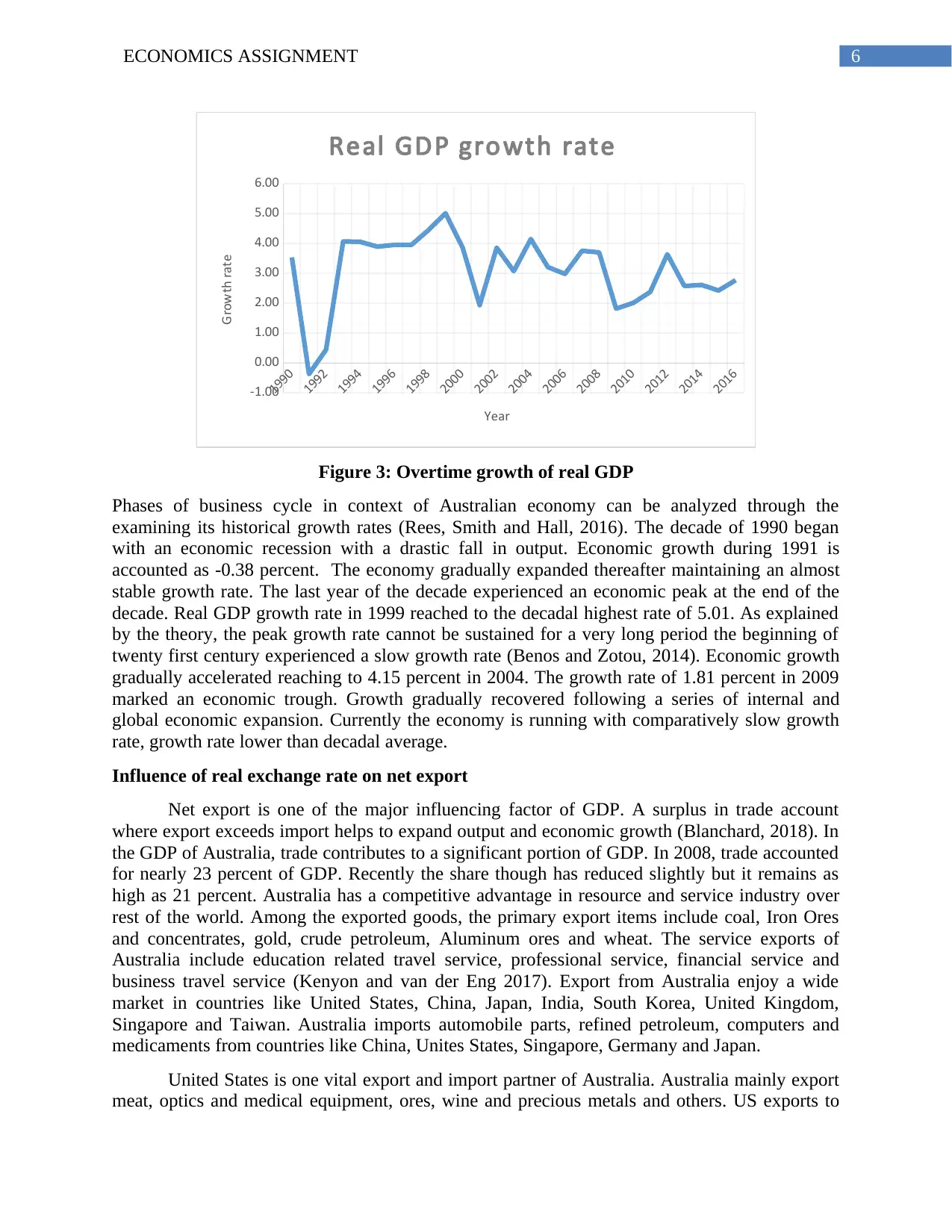
6ECONOMICS ASSIGNMENT
1990
1992
1994
1996
1998
2000
2002
2004
2006
2008
2010
2012
2014
2016
-1.00
0.00
1.00
2.00
3.00
4.00
5.00
6.00
Real GDP growth rate
Year
Growth rate
Figure 3: Overtime growth of real GDP
Phases of business cycle in context of Australian economy can be analyzed through the
examining its historical growth rates (Rees, Smith and Hall, 2016). The decade of 1990 began
with an economic recession with a drastic fall in output. Economic growth during 1991 is
accounted as -0.38 percent. The economy gradually expanded thereafter maintaining an almost
stable growth rate. The last year of the decade experienced an economic peak at the end of the
decade. Real GDP growth rate in 1999 reached to the decadal highest rate of 5.01. As explained
by the theory, the peak growth rate cannot be sustained for a very long period the beginning of
twenty first century experienced a slow growth rate (Benos and Zotou, 2014). Economic growth
gradually accelerated reaching to 4.15 percent in 2004. The growth rate of 1.81 percent in 2009
marked an economic trough. Growth gradually recovered following a series of internal and
global economic expansion. Currently the economy is running with comparatively slow growth
rate, growth rate lower than decadal average.
Influence of real exchange rate on net export
Net export is one of the major influencing factor of GDP. A surplus in trade account
where export exceeds import helps to expand output and economic growth (Blanchard, 2018). In
the GDP of Australia, trade contributes to a significant portion of GDP. In 2008, trade accounted
for nearly 23 percent of GDP. Recently the share though has reduced slightly but it remains as
high as 21 percent. Australia has a competitive advantage in resource and service industry over
rest of the world. Among the exported goods, the primary export items include coal, Iron Ores
and concentrates, gold, crude petroleum, Aluminum ores and wheat. The service exports of
Australia include education related travel service, professional service, financial service and
business travel service (Kenyon and van der Eng 2017). Export from Australia enjoy a wide
market in countries like United States, China, Japan, India, South Korea, United Kingdom,
Singapore and Taiwan. Australia imports automobile parts, refined petroleum, computers and
medicaments from countries like China, Unites States, Singapore, Germany and Japan.
United States is one vital export and import partner of Australia. Australia mainly export
meat, optics and medical equipment, ores, wine and precious metals and others. US exports to
1990
1992
1994
1996
1998
2000
2002
2004
2006
2008
2010
2012
2014
2016
-1.00
0.00
1.00
2.00
3.00
4.00
5.00
6.00
Real GDP growth rate
Year
Growth rate
Figure 3: Overtime growth of real GDP
Phases of business cycle in context of Australian economy can be analyzed through the
examining its historical growth rates (Rees, Smith and Hall, 2016). The decade of 1990 began
with an economic recession with a drastic fall in output. Economic growth during 1991 is
accounted as -0.38 percent. The economy gradually expanded thereafter maintaining an almost
stable growth rate. The last year of the decade experienced an economic peak at the end of the
decade. Real GDP growth rate in 1999 reached to the decadal highest rate of 5.01. As explained
by the theory, the peak growth rate cannot be sustained for a very long period the beginning of
twenty first century experienced a slow growth rate (Benos and Zotou, 2014). Economic growth
gradually accelerated reaching to 4.15 percent in 2004. The growth rate of 1.81 percent in 2009
marked an economic trough. Growth gradually recovered following a series of internal and
global economic expansion. Currently the economy is running with comparatively slow growth
rate, growth rate lower than decadal average.
Influence of real exchange rate on net export
Net export is one of the major influencing factor of GDP. A surplus in trade account
where export exceeds import helps to expand output and economic growth (Blanchard, 2018). In
the GDP of Australia, trade contributes to a significant portion of GDP. In 2008, trade accounted
for nearly 23 percent of GDP. Recently the share though has reduced slightly but it remains as
high as 21 percent. Australia has a competitive advantage in resource and service industry over
rest of the world. Among the exported goods, the primary export items include coal, Iron Ores
and concentrates, gold, crude petroleum, Aluminum ores and wheat. The service exports of
Australia include education related travel service, professional service, financial service and
business travel service (Kenyon and van der Eng 2017). Export from Australia enjoy a wide
market in countries like United States, China, Japan, India, South Korea, United Kingdom,
Singapore and Taiwan. Australia imports automobile parts, refined petroleum, computers and
medicaments from countries like China, Unites States, Singapore, Germany and Japan.
United States is one vital export and import partner of Australia. Australia mainly export
meat, optics and medical equipment, ores, wine and precious metals and others. US exports to
Paraphrase This Document
Need a fresh take? Get an instant paraphrase of this document with our AI Paraphraser
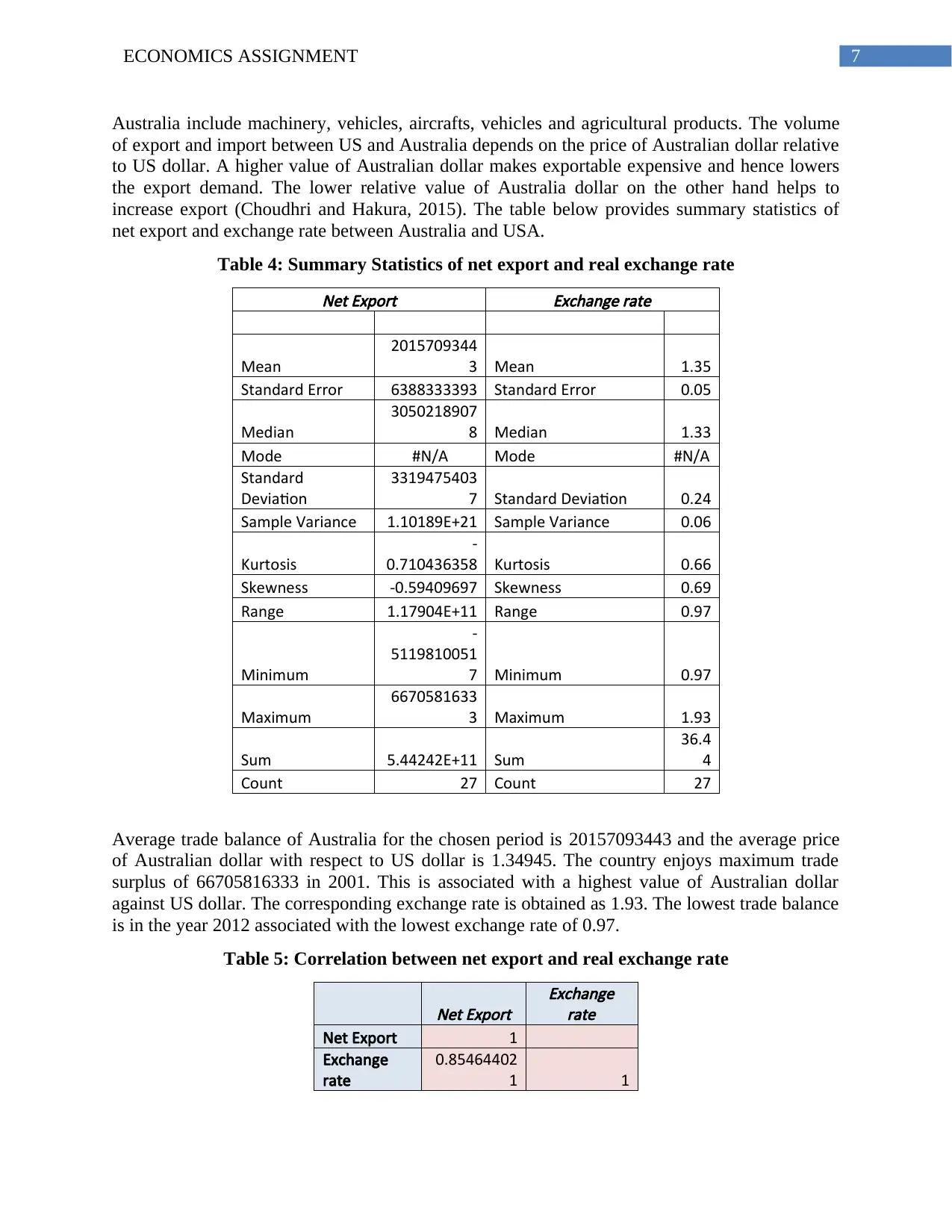
7ECONOMICS ASSIGNMENT
Australia include machinery, vehicles, aircrafts, vehicles and agricultural products. The volume
of export and import between US and Australia depends on the price of Australian dollar relative
to US dollar. A higher value of Australian dollar makes exportable expensive and hence lowers
the export demand. The lower relative value of Australia dollar on the other hand helps to
increase export (Choudhri and Hakura, 2015). The table below provides summary statistics of
net export and exchange rate between Australia and USA.
Table 4: Summary Statistics of net export and real exchange rate
Net Export
Exchange rate
Mean
2015709344
3 Mean 1.35
Standard Error 6388333393 Standard Error 0.05
Median
3050218907
8 Median 1.33
Mode #N/A Mode #N/A
Standard
Deviation
3319475403
7 Standard Deviation 0.24
Sample Variance 1.10189E+21 Sample Variance 0.06
Kurtosis
-
0.710436358 Kurtosis 0.66
Skewness -0.59409697 Skewness 0.69
Range 1.17904E+11 Range 0.97
Minimum
-
5119810051
7 Minimum 0.97
Maximum
6670581633
3 Maximum 1.93
Sum 5.44242E+11 Sum
36.4
4
Count 27 Count 27
Average trade balance of Australia for the chosen period is 20157093443 and the average price
of Australian dollar with respect to US dollar is 1.34945. The country enjoys maximum trade
surplus of 66705816333 in 2001. This is associated with a highest value of Australian dollar
against US dollar. The corresponding exchange rate is obtained as 1.93. The lowest trade balance
is in the year 2012 associated with the lowest exchange rate of 0.97.
Table 5: Correlation between net export and real exchange rate
Net Export
Exchange
rate
Net Export 1
Exchange
rate
0.85464402
1 1
Australia include machinery, vehicles, aircrafts, vehicles and agricultural products. The volume
of export and import between US and Australia depends on the price of Australian dollar relative
to US dollar. A higher value of Australian dollar makes exportable expensive and hence lowers
the export demand. The lower relative value of Australia dollar on the other hand helps to
increase export (Choudhri and Hakura, 2015). The table below provides summary statistics of
net export and exchange rate between Australia and USA.
Table 4: Summary Statistics of net export and real exchange rate
Net Export
Exchange rate
Mean
2015709344
3 Mean 1.35
Standard Error 6388333393 Standard Error 0.05
Median
3050218907
8 Median 1.33
Mode #N/A Mode #N/A
Standard
Deviation
3319475403
7 Standard Deviation 0.24
Sample Variance 1.10189E+21 Sample Variance 0.06
Kurtosis
-
0.710436358 Kurtosis 0.66
Skewness -0.59409697 Skewness 0.69
Range 1.17904E+11 Range 0.97
Minimum
-
5119810051
7 Minimum 0.97
Maximum
6670581633
3 Maximum 1.93
Sum 5.44242E+11 Sum
36.4
4
Count 27 Count 27
Average trade balance of Australia for the chosen period is 20157093443 and the average price
of Australian dollar with respect to US dollar is 1.34945. The country enjoys maximum trade
surplus of 66705816333 in 2001. This is associated with a highest value of Australian dollar
against US dollar. The corresponding exchange rate is obtained as 1.93. The lowest trade balance
is in the year 2012 associated with the lowest exchange rate of 0.97.
Table 5: Correlation between net export and real exchange rate
Net Export
Exchange
rate
Net Export 1
Exchange
rate
0.85464402
1 1
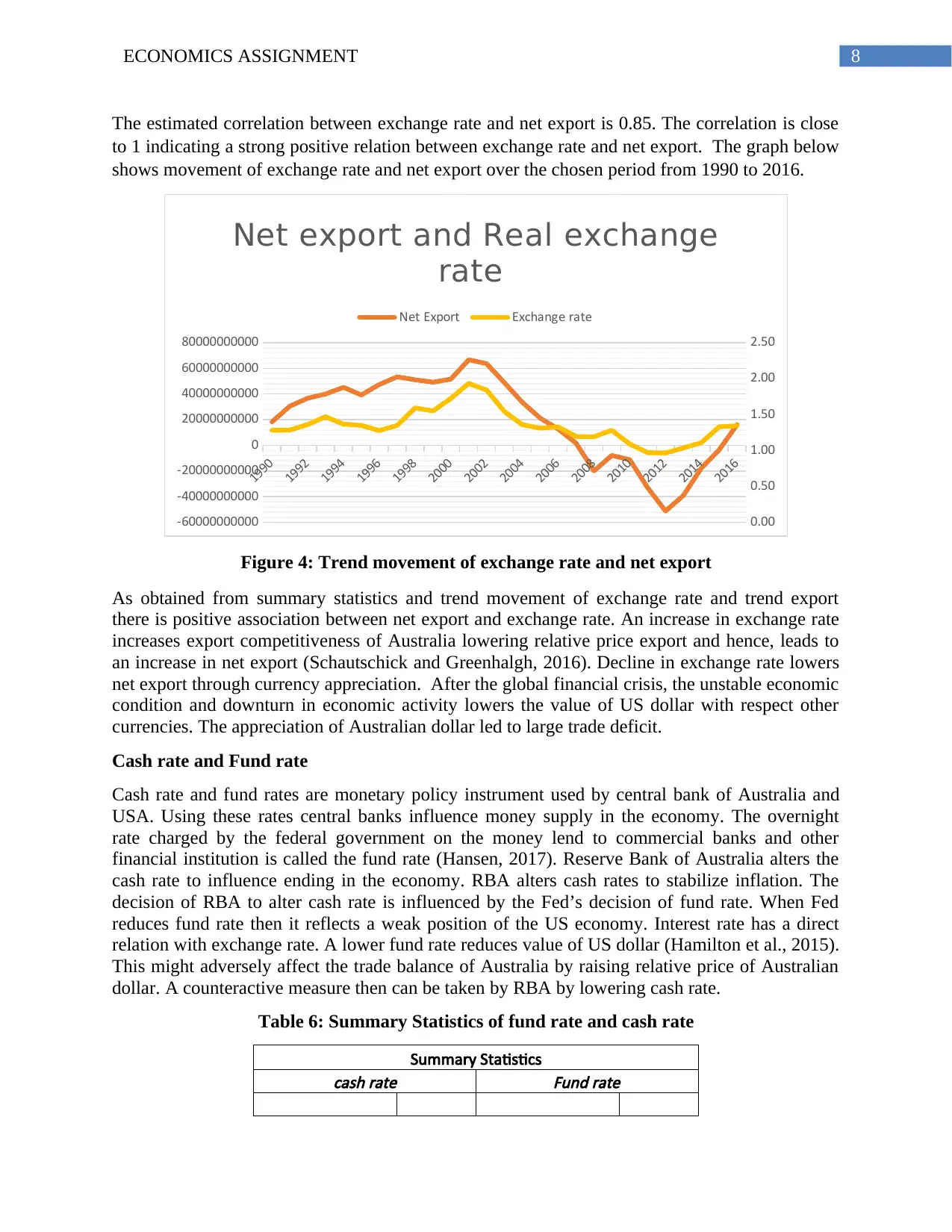
8ECONOMICS ASSIGNMENT
The estimated correlation between exchange rate and net export is 0.85. The correlation is close
to 1 indicating a strong positive relation between exchange rate and net export. The graph below
shows movement of exchange rate and net export over the chosen period from 1990 to 2016.
1990
1992
1994
1996
1998
2000
2002
2004
2006
2008
2010
2012
2014
2016
-60000000000
-40000000000
-20000000000
0
20000000000
40000000000
60000000000
80000000000
0.00
0.50
1.00
1.50
2.00
2.50
Net export and Real exchange
rate
Net Export Exchange rate
Figure 4: Trend movement of exchange rate and net export
As obtained from summary statistics and trend movement of exchange rate and trend export
there is positive association between net export and exchange rate. An increase in exchange rate
increases export competitiveness of Australia lowering relative price export and hence, leads to
an increase in net export (Schautschick and Greenhalgh, 2016). Decline in exchange rate lowers
net export through currency appreciation. After the global financial crisis, the unstable economic
condition and downturn in economic activity lowers the value of US dollar with respect other
currencies. The appreciation of Australian dollar led to large trade deficit.
Cash rate and Fund rate
Cash rate and fund rates are monetary policy instrument used by central bank of Australia and
USA. Using these rates central banks influence money supply in the economy. The overnight
rate charged by the federal government on the money lend to commercial banks and other
financial institution is called the fund rate (Hansen, 2017). Reserve Bank of Australia alters the
cash rate to influence ending in the economy. RBA alters cash rates to stabilize inflation. The
decision of RBA to alter cash rate is influenced by the Fed’s decision of fund rate. When Fed
reduces fund rate then it reflects a weak position of the US economy. Interest rate has a direct
relation with exchange rate. A lower fund rate reduces value of US dollar (Hamilton et al., 2015).
This might adversely affect the trade balance of Australia by raising relative price of Australian
dollar. A counteractive measure then can be taken by RBA by lowering cash rate.
Table 6: Summary Statistics of fund rate and cash rate
Summary Statistics
cash rate
Fund rate
The estimated correlation between exchange rate and net export is 0.85. The correlation is close
to 1 indicating a strong positive relation between exchange rate and net export. The graph below
shows movement of exchange rate and net export over the chosen period from 1990 to 2016.
1990
1992
1994
1996
1998
2000
2002
2004
2006
2008
2010
2012
2014
2016
-60000000000
-40000000000
-20000000000
0
20000000000
40000000000
60000000000
80000000000
0.00
0.50
1.00
1.50
2.00
2.50
Net export and Real exchange
rate
Net Export Exchange rate
Figure 4: Trend movement of exchange rate and net export
As obtained from summary statistics and trend movement of exchange rate and trend export
there is positive association between net export and exchange rate. An increase in exchange rate
increases export competitiveness of Australia lowering relative price export and hence, leads to
an increase in net export (Schautschick and Greenhalgh, 2016). Decline in exchange rate lowers
net export through currency appreciation. After the global financial crisis, the unstable economic
condition and downturn in economic activity lowers the value of US dollar with respect other
currencies. The appreciation of Australian dollar led to large trade deficit.
Cash rate and Fund rate
Cash rate and fund rates are monetary policy instrument used by central bank of Australia and
USA. Using these rates central banks influence money supply in the economy. The overnight
rate charged by the federal government on the money lend to commercial banks and other
financial institution is called the fund rate (Hansen, 2017). Reserve Bank of Australia alters the
cash rate to influence ending in the economy. RBA alters cash rates to stabilize inflation. The
decision of RBA to alter cash rate is influenced by the Fed’s decision of fund rate. When Fed
reduces fund rate then it reflects a weak position of the US economy. Interest rate has a direct
relation with exchange rate. A lower fund rate reduces value of US dollar (Hamilton et al., 2015).
This might adversely affect the trade balance of Australia by raising relative price of Australian
dollar. A counteractive measure then can be taken by RBA by lowering cash rate.
Table 6: Summary Statistics of fund rate and cash rate
Summary Statistics
cash rate
Fund rate
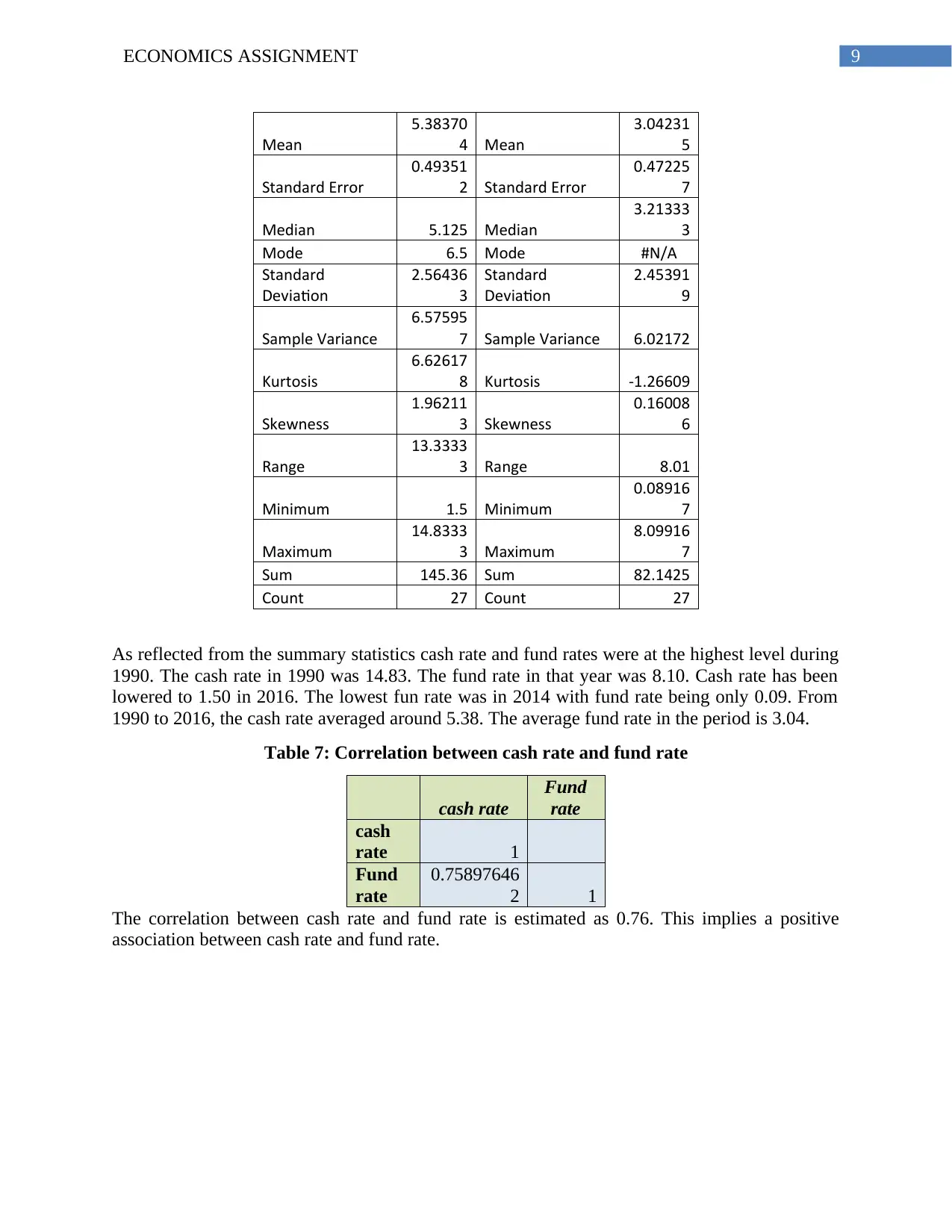
9ECONOMICS ASSIGNMENT
Mean
5.38370
4 Mean
3.04231
5
Standard Error
0.49351
2 Standard Error
0.47225
7
Median 5.125 Median
3.21333
3
Mode 6.5 Mode #N/A
Standard
Deviation
2.56436
3
Standard
Deviation
2.45391
9
Sample Variance
6.57595
7 Sample Variance 6.02172
Kurtosis
6.62617
8 Kurtosis -1.26609
Skewness
1.96211
3 Skewness
0.16008
6
Range
13.3333
3 Range 8.01
Minimum 1.5 Minimum
0.08916
7
Maximum
14.8333
3 Maximum
8.09916
7
Sum 145.36 Sum 82.1425
Count 27 Count 27
As reflected from the summary statistics cash rate and fund rates were at the highest level during
1990. The cash rate in 1990 was 14.83. The fund rate in that year was 8.10. Cash rate has been
lowered to 1.50 in 2016. The lowest fun rate was in 2014 with fund rate being only 0.09. From
1990 to 2016, the cash rate averaged around 5.38. The average fund rate in the period is 3.04.
Table 7: Correlation between cash rate and fund rate
cash rate
Fund
rate
cash
rate 1
Fund
rate
0.75897646
2 1
The correlation between cash rate and fund rate is estimated as 0.76. This implies a positive
association between cash rate and fund rate.
Mean
5.38370
4 Mean
3.04231
5
Standard Error
0.49351
2 Standard Error
0.47225
7
Median 5.125 Median
3.21333
3
Mode 6.5 Mode #N/A
Standard
Deviation
2.56436
3
Standard
Deviation
2.45391
9
Sample Variance
6.57595
7 Sample Variance 6.02172
Kurtosis
6.62617
8 Kurtosis -1.26609
Skewness
1.96211
3 Skewness
0.16008
6
Range
13.3333
3 Range 8.01
Minimum 1.5 Minimum
0.08916
7
Maximum
14.8333
3 Maximum
8.09916
7
Sum 145.36 Sum 82.1425
Count 27 Count 27
As reflected from the summary statistics cash rate and fund rates were at the highest level during
1990. The cash rate in 1990 was 14.83. The fund rate in that year was 8.10. Cash rate has been
lowered to 1.50 in 2016. The lowest fun rate was in 2014 with fund rate being only 0.09. From
1990 to 2016, the cash rate averaged around 5.38. The average fund rate in the period is 3.04.
Table 7: Correlation between cash rate and fund rate
cash rate
Fund
rate
cash
rate 1
Fund
rate
0.75897646
2 1
The correlation between cash rate and fund rate is estimated as 0.76. This implies a positive
association between cash rate and fund rate.
Secure Best Marks with AI Grader
Need help grading? Try our AI Grader for instant feedback on your assignments.
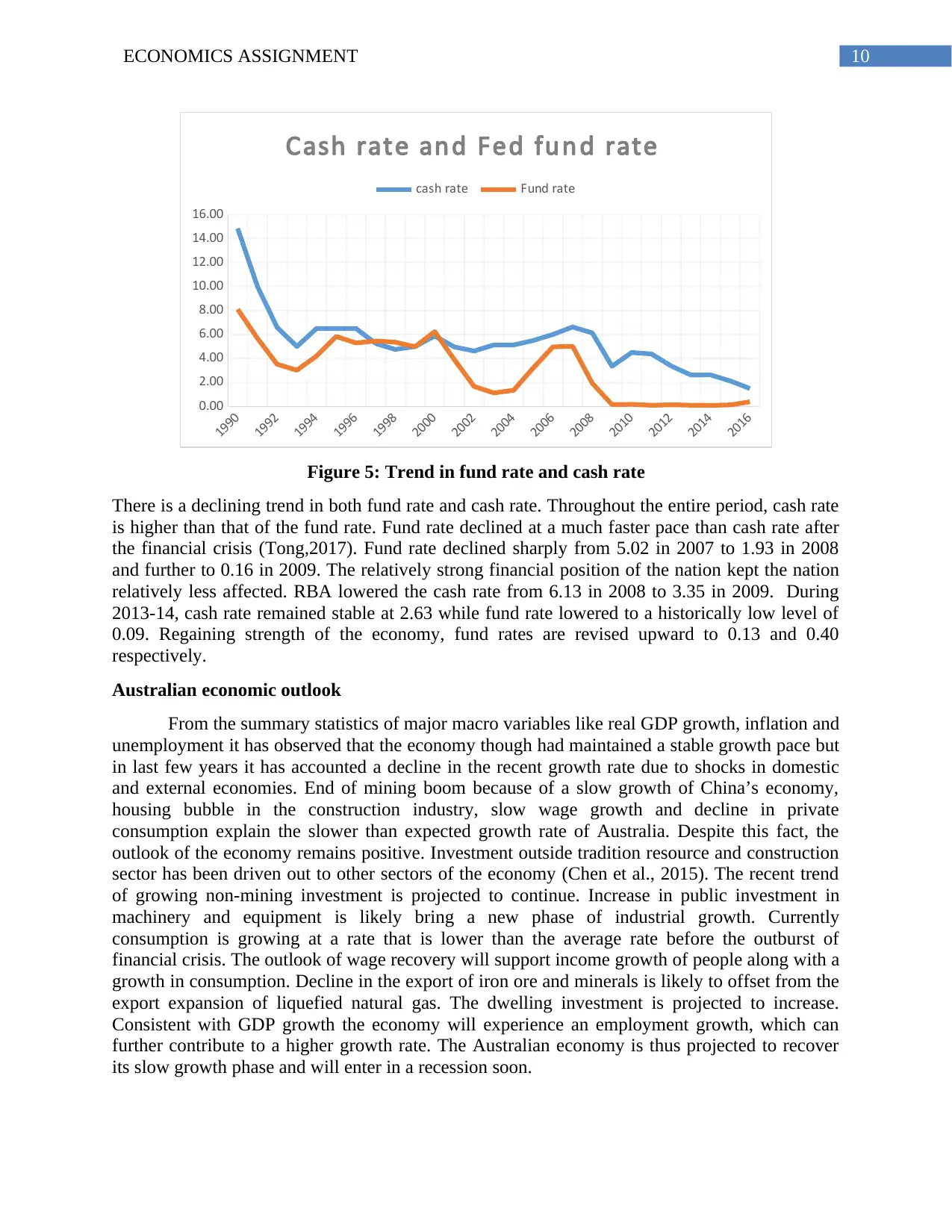
10ECONOMICS ASSIGNMENT
1990
1992
1994
1996
1998
2000
2002
2004
2006
2008
2010
2012
2014
2016
0.00
2.00
4.00
6.00
8.00
10.00
12.00
14.00
16.00
Cash rate and Fed fun d rate
cash rate Fund rate
Figure 5: Trend in fund rate and cash rate
There is a declining trend in both fund rate and cash rate. Throughout the entire period, cash rate
is higher than that of the fund rate. Fund rate declined at a much faster pace than cash rate after
the financial crisis (Tong,2017). Fund rate declined sharply from 5.02 in 2007 to 1.93 in 2008
and further to 0.16 in 2009. The relatively strong financial position of the nation kept the nation
relatively less affected. RBA lowered the cash rate from 6.13 in 2008 to 3.35 in 2009. During
2013-14, cash rate remained stable at 2.63 while fund rate lowered to a historically low level of
0.09. Regaining strength of the economy, fund rates are revised upward to 0.13 and 0.40
respectively.
Australian economic outlook
From the summary statistics of major macro variables like real GDP growth, inflation and
unemployment it has observed that the economy though had maintained a stable growth pace but
in last few years it has accounted a decline in the recent growth rate due to shocks in domestic
and external economies. End of mining boom because of a slow growth of China’s economy,
housing bubble in the construction industry, slow wage growth and decline in private
consumption explain the slower than expected growth rate of Australia. Despite this fact, the
outlook of the economy remains positive. Investment outside tradition resource and construction
sector has been driven out to other sectors of the economy (Chen et al., 2015). The recent trend
of growing non-mining investment is projected to continue. Increase in public investment in
machinery and equipment is likely bring a new phase of industrial growth. Currently
consumption is growing at a rate that is lower than the average rate before the outburst of
financial crisis. The outlook of wage recovery will support income growth of people along with a
growth in consumption. Decline in the export of iron ore and minerals is likely to offset from the
export expansion of liquefied natural gas. The dwelling investment is projected to increase.
Consistent with GDP growth the economy will experience an employment growth, which can
further contribute to a higher growth rate. The Australian economy is thus projected to recover
its slow growth phase and will enter in a recession soon.
1990
1992
1994
1996
1998
2000
2002
2004
2006
2008
2010
2012
2014
2016
0.00
2.00
4.00
6.00
8.00
10.00
12.00
14.00
16.00
Cash rate and Fed fun d rate
cash rate Fund rate
Figure 5: Trend in fund rate and cash rate
There is a declining trend in both fund rate and cash rate. Throughout the entire period, cash rate
is higher than that of the fund rate. Fund rate declined at a much faster pace than cash rate after
the financial crisis (Tong,2017). Fund rate declined sharply from 5.02 in 2007 to 1.93 in 2008
and further to 0.16 in 2009. The relatively strong financial position of the nation kept the nation
relatively less affected. RBA lowered the cash rate from 6.13 in 2008 to 3.35 in 2009. During
2013-14, cash rate remained stable at 2.63 while fund rate lowered to a historically low level of
0.09. Regaining strength of the economy, fund rates are revised upward to 0.13 and 0.40
respectively.
Australian economic outlook
From the summary statistics of major macro variables like real GDP growth, inflation and
unemployment it has observed that the economy though had maintained a stable growth pace but
in last few years it has accounted a decline in the recent growth rate due to shocks in domestic
and external economies. End of mining boom because of a slow growth of China’s economy,
housing bubble in the construction industry, slow wage growth and decline in private
consumption explain the slower than expected growth rate of Australia. Despite this fact, the
outlook of the economy remains positive. Investment outside tradition resource and construction
sector has been driven out to other sectors of the economy (Chen et al., 2015). The recent trend
of growing non-mining investment is projected to continue. Increase in public investment in
machinery and equipment is likely bring a new phase of industrial growth. Currently
consumption is growing at a rate that is lower than the average rate before the outburst of
financial crisis. The outlook of wage recovery will support income growth of people along with a
growth in consumption. Decline in the export of iron ore and minerals is likely to offset from the
export expansion of liquefied natural gas. The dwelling investment is projected to increase.
Consistent with GDP growth the economy will experience an employment growth, which can
further contribute to a higher growth rate. The Australian economy is thus projected to recover
its slow growth phase and will enter in a recession soon.
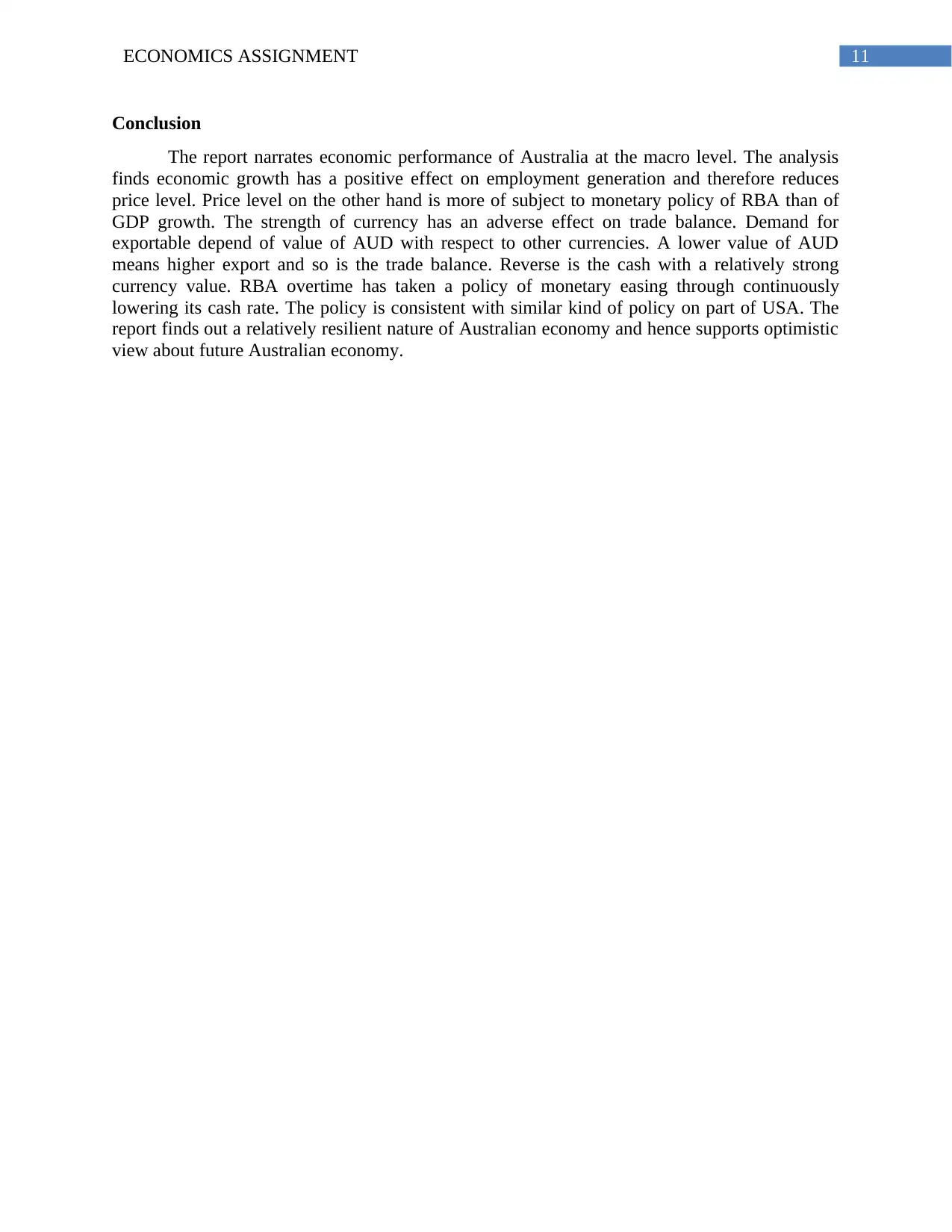
11ECONOMICS ASSIGNMENT
Conclusion
The report narrates economic performance of Australia at the macro level. The analysis
finds economic growth has a positive effect on employment generation and therefore reduces
price level. Price level on the other hand is more of subject to monetary policy of RBA than of
GDP growth. The strength of currency has an adverse effect on trade balance. Demand for
exportable depend of value of AUD with respect to other currencies. A lower value of AUD
means higher export and so is the trade balance. Reverse is the cash with a relatively strong
currency value. RBA overtime has taken a policy of monetary easing through continuously
lowering its cash rate. The policy is consistent with similar kind of policy on part of USA. The
report finds out a relatively resilient nature of Australian economy and hence supports optimistic
view about future Australian economy.
Conclusion
The report narrates economic performance of Australia at the macro level. The analysis
finds economic growth has a positive effect on employment generation and therefore reduces
price level. Price level on the other hand is more of subject to monetary policy of RBA than of
GDP growth. The strength of currency has an adverse effect on trade balance. Demand for
exportable depend of value of AUD with respect to other currencies. A lower value of AUD
means higher export and so is the trade balance. Reverse is the cash with a relatively strong
currency value. RBA overtime has taken a policy of monetary easing through continuously
lowering its cash rate. The policy is consistent with similar kind of policy on part of USA. The
report finds out a relatively resilient nature of Australian economy and hence supports optimistic
view about future Australian economy.
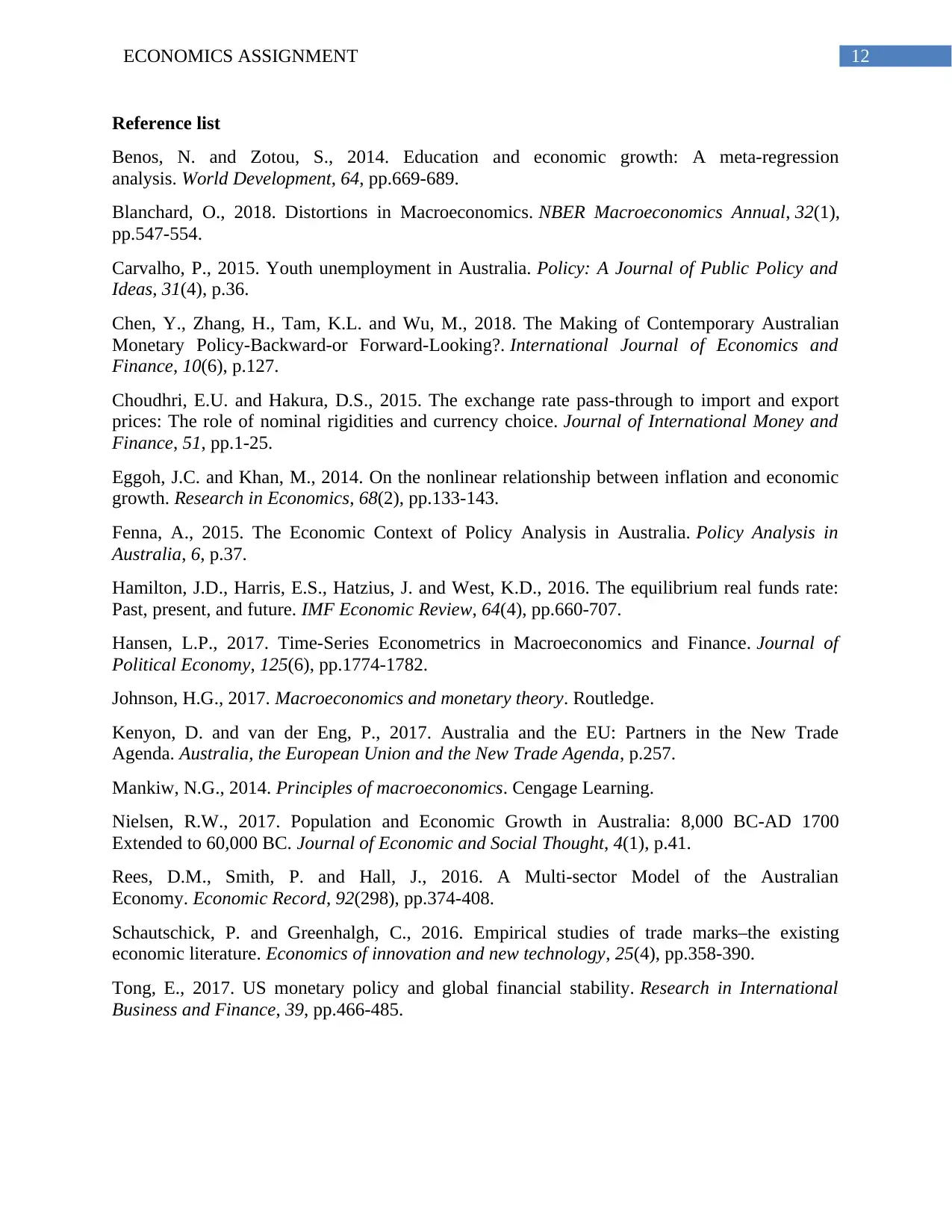
12ECONOMICS ASSIGNMENT
Reference list
Benos, N. and Zotou, S., 2014. Education and economic growth: A meta-regression
analysis. World Development, 64, pp.669-689.
Blanchard, O., 2018. Distortions in Macroeconomics. NBER Macroeconomics Annual, 32(1),
pp.547-554.
Carvalho, P., 2015. Youth unemployment in Australia. Policy: A Journal of Public Policy and
Ideas, 31(4), p.36.
Chen, Y., Zhang, H., Tam, K.L. and Wu, M., 2018. The Making of Contemporary Australian
Monetary Policy-Backward-or Forward-Looking?. International Journal of Economics and
Finance, 10(6), p.127.
Choudhri, E.U. and Hakura, D.S., 2015. The exchange rate pass-through to import and export
prices: The role of nominal rigidities and currency choice. Journal of International Money and
Finance, 51, pp.1-25.
Eggoh, J.C. and Khan, M., 2014. On the nonlinear relationship between inflation and economic
growth. Research in Economics, 68(2), pp.133-143.
Fenna, A., 2015. The Economic Context of Policy Analysis in Australia. Policy Analysis in
Australia, 6, p.37.
Hamilton, J.D., Harris, E.S., Hatzius, J. and West, K.D., 2016. The equilibrium real funds rate:
Past, present, and future. IMF Economic Review, 64(4), pp.660-707.
Hansen, L.P., 2017. Time-Series Econometrics in Macroeconomics and Finance. Journal of
Political Economy, 125(6), pp.1774-1782.
Johnson, H.G., 2017. Macroeconomics and monetary theory. Routledge.
Kenyon, D. and van der Eng, P., 2017. Australia and the EU: Partners in the New Trade
Agenda. Australia, the European Union and the New Trade Agenda, p.257.
Mankiw, N.G., 2014. Principles of macroeconomics. Cengage Learning.
Nielsen, R.W., 2017. Population and Economic Growth in Australia: 8,000 BC-AD 1700
Extended to 60,000 BC. Journal of Economic and Social Thought, 4(1), p.41.
Rees, D.M., Smith, P. and Hall, J., 2016. A Multi‐sector Model of the Australian
Economy. Economic Record, 92(298), pp.374-408.
Schautschick, P. and Greenhalgh, C., 2016. Empirical studies of trade marks–the existing
economic literature. Economics of innovation and new technology, 25(4), pp.358-390.
Tong, E., 2017. US monetary policy and global financial stability. Research in International
Business and Finance, 39, pp.466-485.
Reference list
Benos, N. and Zotou, S., 2014. Education and economic growth: A meta-regression
analysis. World Development, 64, pp.669-689.
Blanchard, O., 2018. Distortions in Macroeconomics. NBER Macroeconomics Annual, 32(1),
pp.547-554.
Carvalho, P., 2015. Youth unemployment in Australia. Policy: A Journal of Public Policy and
Ideas, 31(4), p.36.
Chen, Y., Zhang, H., Tam, K.L. and Wu, M., 2018. The Making of Contemporary Australian
Monetary Policy-Backward-or Forward-Looking?. International Journal of Economics and
Finance, 10(6), p.127.
Choudhri, E.U. and Hakura, D.S., 2015. The exchange rate pass-through to import and export
prices: The role of nominal rigidities and currency choice. Journal of International Money and
Finance, 51, pp.1-25.
Eggoh, J.C. and Khan, M., 2014. On the nonlinear relationship between inflation and economic
growth. Research in Economics, 68(2), pp.133-143.
Fenna, A., 2015. The Economic Context of Policy Analysis in Australia. Policy Analysis in
Australia, 6, p.37.
Hamilton, J.D., Harris, E.S., Hatzius, J. and West, K.D., 2016. The equilibrium real funds rate:
Past, present, and future. IMF Economic Review, 64(4), pp.660-707.
Hansen, L.P., 2017. Time-Series Econometrics in Macroeconomics and Finance. Journal of
Political Economy, 125(6), pp.1774-1782.
Johnson, H.G., 2017. Macroeconomics and monetary theory. Routledge.
Kenyon, D. and van der Eng, P., 2017. Australia and the EU: Partners in the New Trade
Agenda. Australia, the European Union and the New Trade Agenda, p.257.
Mankiw, N.G., 2014. Principles of macroeconomics. Cengage Learning.
Nielsen, R.W., 2017. Population and Economic Growth in Australia: 8,000 BC-AD 1700
Extended to 60,000 BC. Journal of Economic and Social Thought, 4(1), p.41.
Rees, D.M., Smith, P. and Hall, J., 2016. A Multi‐sector Model of the Australian
Economy. Economic Record, 92(298), pp.374-408.
Schautschick, P. and Greenhalgh, C., 2016. Empirical studies of trade marks–the existing
economic literature. Economics of innovation and new technology, 25(4), pp.358-390.
Tong, E., 2017. US monetary policy and global financial stability. Research in International
Business and Finance, 39, pp.466-485.
Paraphrase This Document
Need a fresh take? Get an instant paraphrase of this document with our AI Paraphraser
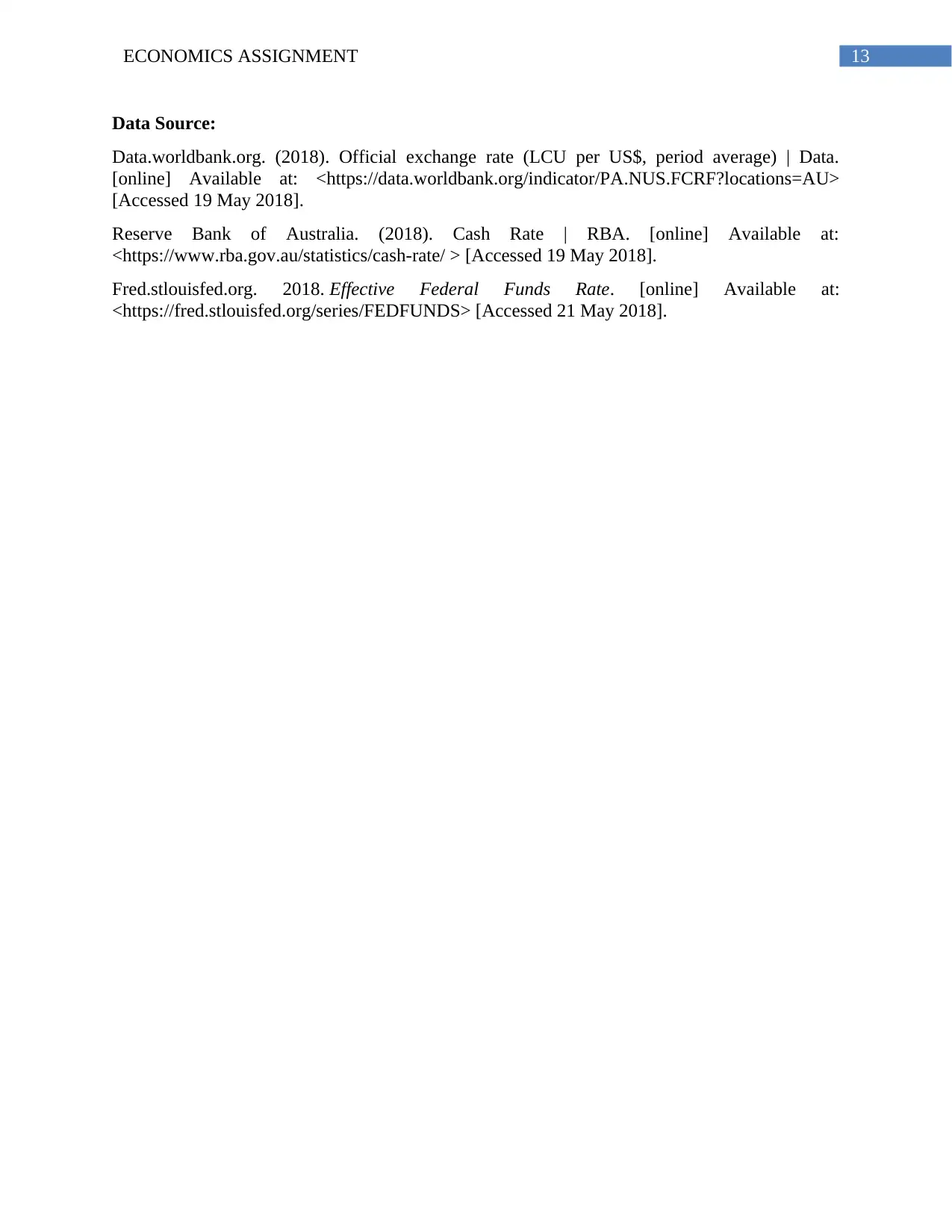
13ECONOMICS ASSIGNMENT
Data Source:
Data.worldbank.org. (2018). Official exchange rate (LCU per US$, period average) | Data.
[online] Available at: <https://data.worldbank.org/indicator/PA.NUS.FCRF?locations=AU>
[Accessed 19 May 2018].
Reserve Bank of Australia. (2018). Cash Rate | RBA. [online] Available at:
<https://www.rba.gov.au/statistics/cash-rate/ > [Accessed 19 May 2018].
Fred.stlouisfed.org. 2018. Effective Federal Funds Rate. [online] Available at:
<https://fred.stlouisfed.org/series/FEDFUNDS> [Accessed 21 May 2018].
Data Source:
Data.worldbank.org. (2018). Official exchange rate (LCU per US$, period average) | Data.
[online] Available at: <https://data.worldbank.org/indicator/PA.NUS.FCRF?locations=AU>
[Accessed 19 May 2018].
Reserve Bank of Australia. (2018). Cash Rate | RBA. [online] Available at:
<https://www.rba.gov.au/statistics/cash-rate/ > [Accessed 19 May 2018].
Fred.stlouisfed.org. 2018. Effective Federal Funds Rate. [online] Available at:
<https://fred.stlouisfed.org/series/FEDFUNDS> [Accessed 21 May 2018].
1 out of 14
Related Documents
Your All-in-One AI-Powered Toolkit for Academic Success.
+13062052269
info@desklib.com
Available 24*7 on WhatsApp / Email
![[object Object]](/_next/static/media/star-bottom.7253800d.svg)
Unlock your academic potential
© 2024 | Zucol Services PVT LTD | All rights reserved.




